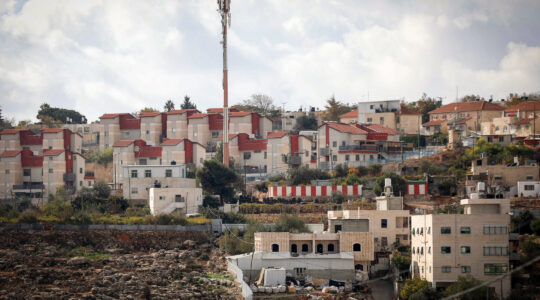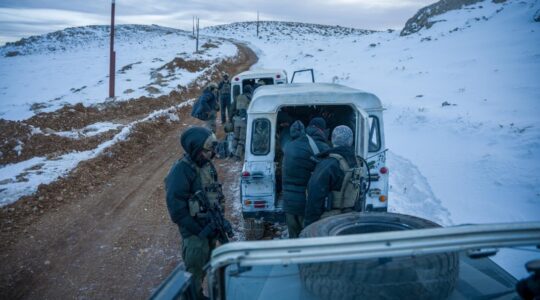GAZA (JTA) — Perched on the third-floor balcony of a commandeered Palestinian villa, Lt.-Col. Yehuda gazes over the Gaza Strip, his posture suggesting a man in repose rather than a soldier poised to press home an offensive.
“I think Hamas has already folded,” he says when asked to sum up the resistance Israeli troops encountered when they stormed into the enclave last week as part of a ground, air and sea campaign to counter rocket salvoes by the Islamist movement.
Apologizing for a voice almost inaudibly hoarse, he says, “It’s from shouting at my guys not to let themselves become complacent. But things have been getting busier at night. That’s when the snipers try to close in and get a shot.”
Under a crisp winter sunset, it’s a still, sad vista.
To the north, the teeming city of Gaza has been encircled by Israeli forces and pounded by the Air Force as part of a campaign to counter Palestinian rocket fire. To the west and east, tanks have churned up swathes of farmland and crushed buildings.
Though Palestinians continue to launch their short-range missiles sporadically into Israel, from this vantage point there are few signs of life other than the cautious criss-cross of Israeli armor in the three miles of fields from border to beach.
More than 900 Palestinians, many of them civilians, have died in an Israeli offensive that has drawn international condemnation for its humanitarian toll. Israel says Hamas invites such carnage by fighting in populated areas.
Over Gaza’s nearby coastal highway, a decorative arch carries a lone green Hamas flag. No cars travel under it now, though the Israelis say there is civilian traffic during daily three-hour truces enacted as part of a “humanitarian corridor.”
Having bisected the strip by straddling its main roads, Israeli troops are probing ever deeper into Gaza’s population centers, trying to draw out Palestinian gunmen while waiting for the government to decide whether to order a full-on assault.
“We are tightening the encirclement of the city,” the offensive’s commander, Brig. Eyal Eisenberg, told a small group of reporters brought in to observe the deployment. “We are not static. We are careful to be constantly on the move.”
There has been disappointment in Israel that the initial push had not led to fiercer clashes in which more damage could have been inflicted on Hamas. Taking the fight into the cities, however, could expose troops to a greater risk of ambush.
Military commanders say they are ready for a more congested close-quarters battle. The tactics so far suggest that Israel’s doctrine comes down to moving slowly but shooting readily.
Leading an armored column to the beachfront, a tank crew spots someone standing in an open cabana nearly a mile away. The tank’s onboard heavy machine gun chatters and tracer bullets wing over the structure. The figure disappears.
“There have been several attempts to use anti-armor weaponry against us, in at least one case a long-range missile,” says Lt.-Col. Erez, a tank commander, giving only his first name, in line with standard military policy. “We have responded pre-emptively and forcefully. We also hit anyone seen trying to observe our movements.”
Ten Israeli soldiers have been killed so far.
“We came across several houses that were booby-trapped, either with regular explosives or by sealing the windows and doors and leaving the cooking gas on,” Yehuda says.
The latter tactic shows the attentiveness of Palestinian factions, who are seasoned by past confrontations and determined to cause casualties that they might claim as a victory against the Jewish state.
Yehuda says it is standard practice for Israeli troops to enter suspicious buildings with bursts of shooting to stave off a doorway attack. Such gunfire is enough to ignite gas.
“In one case the building started burning, but we managed to clear out our men in time,” Yehuda says.
He says troops also killed three gunmen who emerged from a bunker and a suspected suicide bomber who approached on a bicycle. Both times they used bulldozers to bury the enemies.
Another concern for Israel has been the matrix of obstacles — minefields, hidden gun nests, rocket silos — prepared well in advance by Hamas.
Tanks appear to have avoided roads in many cases, the deep furrows of their tracks now plowed across fields to the sea.
There, an expanse of white sand is unmarked apart from three untended fishing boats. An Israeli colonel, Yigal, jokes with his men about wanting to return one day for a long vacation.
But then it’s dark, and as the tank and armored personnel carrier crews switch to night-vision goggles they grow somber.
Surging back across the wasteland, the lead tank stops as it receives a report of a five-man Palestinian squad 300 yards away launching mortars at an Israeli position.
A frenzied exchange over the radio ensues to ensure the squad is indeed hostile. Approval comes in; the tank fires three shells. Three of the five are killed, the gunner says.
JTA has documented Jewish history in real-time for over a century. Keep our journalism strong by joining us in supporting independent, award-winning reporting.





